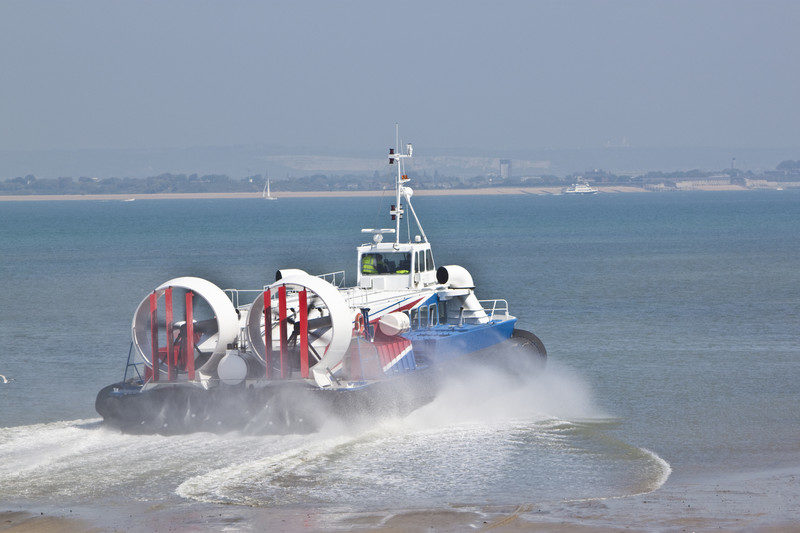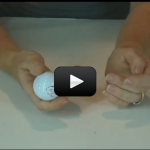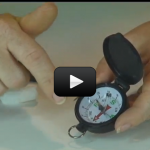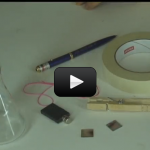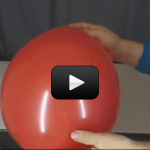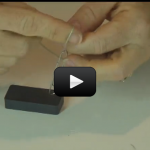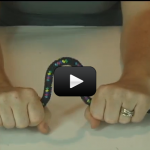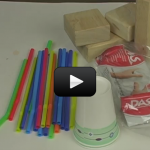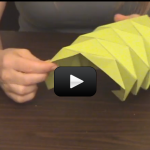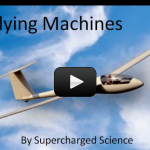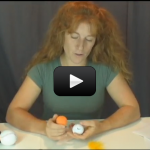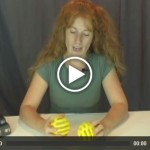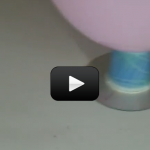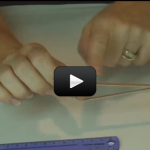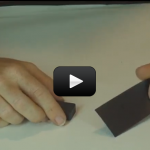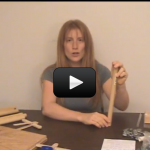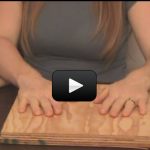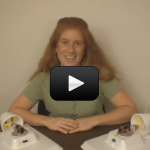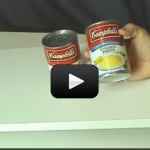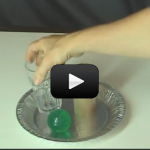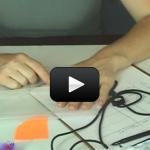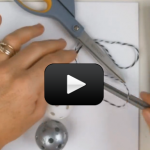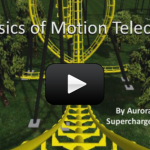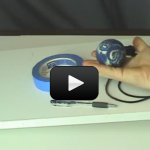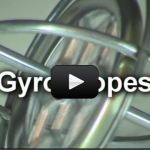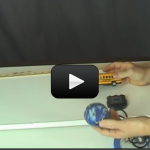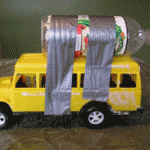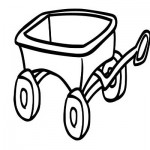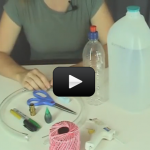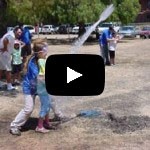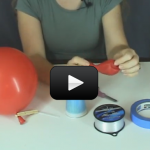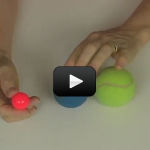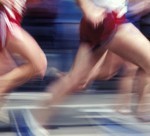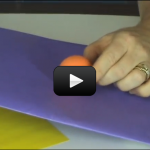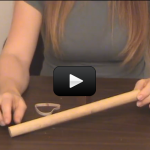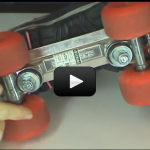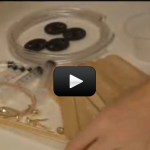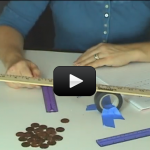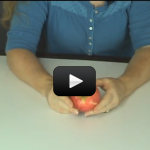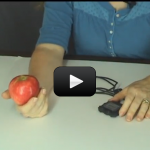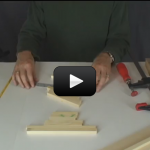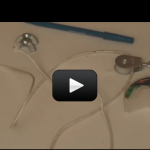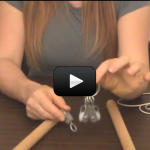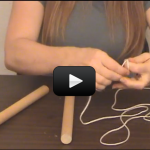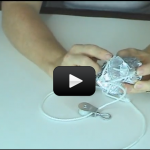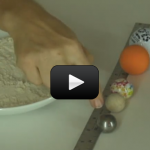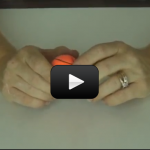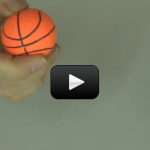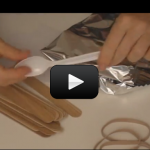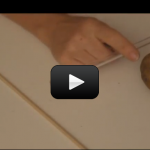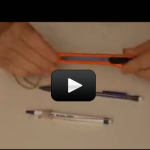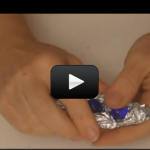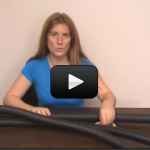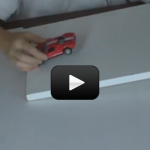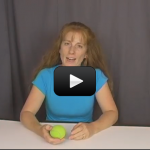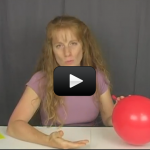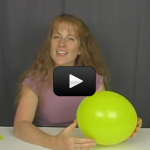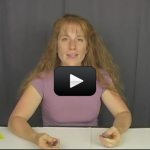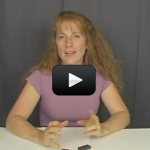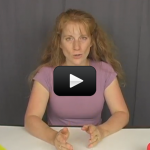Detecting the Gravitational Field
Ok, sort of a silly experiment I admit. But here's what we're going for - there is an invisible force acting on you and the ball. As you will see in later lessons, things don’t change the way they are moving unless a force acts on them. When you jump, the force that we call gravity pulled you back to Earth. |
Detecting the Magnetic Field
Remember, there are four different kinds of forces: strong nuclear force,
electromagnetism, weak nuclear force, and gravity. There are also four basic force fields that you come into contact with all the time. |
The Electromagnetic Field
The electromagnetic field is a bit strange. It is caused by either a magnetic field or an electric field moving. If a magnetic field moves, it creates an electric field. If an electric field moves, it creates a magnetic field. |
Detecting the Electric Field
You are actually fairly familiar with electric fields too, but you may not know it. Have you ever rubbed your feet against the floor and then shocked your brother or sister? |
Flying Paper Clip
Have you ever been close to something that smells bad? Have you noticed that the farther you get from that something, the less it smells, and the closer you get, the more it smells? Well forces sort of work in the same way. |
Force-full Cereal
Did you know that your cereal may be magnetic? Depending on the brand of cereal you enjoy in the morning, you'll be able to see the magnetic effects right in your bowl. You don't have to eat this experiment when you're done |
Net Forces
It is very rare, especially on Earth, to have an object that is experiencing force from only one direction. A bicycle rider has the force of air friction pushing against him. He has to fight against the friction between the gears and the wheels. |
Building Bridges
What keeps building from toppling over in the wind? Why are some earthquake-proof and others not? We're going to look at how engineers design buildings and bridges while making our own. |
Barrel Roof
This roof can support over 400 times its own weight, and you don't need tape! One of the great things about net forces is that although the objects can be under tremendous force, nothing moves! |
Special Science Teleclass: Flying Machines
This is a recording of a recent live teleclass I did with thousands of kids from all over the world. I’ve included it here so you can participate and learn, too! Soar, zoom, fly, twirl, and gyrate with these amazing hands-on classes which investigate the world of flight. Students created flying contraptions from paper airplanes … Continue reading "Special Science Teleclass: Flying Machines" |
Special Science Teleclass: Rocketry & Spaceflight
This is a recording of a recent live teleclass I did with thousands of kids from all over the world. I’ve included it here so you can participate and learn, too! Blast your imagination with this super-popular class on rocketry! Kids learn about fin design, hybrid and solid-state rocketry, and how rockets make it into … Continue reading "Special Science Teleclass: Rocketry & Spaceflight" |
A Weighty Issue
This lesson may give you a sinking sensation but don’t worry about it. It’s only because we’re talking about gravity. You can’t go anywhere without gravity. Even though we deal with gravity on a constant basis |
Forever Falling
If I pitch a ball toward the sunset at the exact same instant that I drop another one from my other hand, which one reaches the ground first? For this experiment, you need |
Fast Ball
You have just taken in a nice bunch of information about the wild world of gravity. This next section is for grades 9-12, who want to go even deeper. There's a lot of great stuff here but there's a lot of math as well. |
Simple Hovercraft
Hovercraft transport people and their stuff across ice, grass, swamp, water, and land. Also known as the Air Cushioned Vehicle (ACV), these machines use air to greatly reduce the sliding friction between the bottom of the vehicle (the skirt) and the ground. |
Tracking your Treads
Now let’s talk about the other ever present force on this Earth, and that’s friction. Friction is the force between one object rubbing against another object. Friction is what makes things slow down. |
What a Drag!
There’s a couple of misconceptions that I’d like to make sure get cleared up here a bit. I don’t want to go into too much detail but I want to make sure to mention these as they may be important as you go deeper into your physics education. |
Stick & Slip
Friction is everywhere! Imagine what the world would be like without friction! Everything you do, from catching baseballs to eating hamburgers, to putting on shoes, friction is a part of it. |
Exponential Friction
Find a smooth, cylindrical support column, such as those used to support open-air roofs for breezeways and outdoor hallways (check your local public school or local church). |
Bearings
Stand on a cookie sheet or cutting board which is placed on the floor (find a smooth floor with no carpet). Ask someone to gently push you across the floor. Notice how much friction they feel as they try to push you. |
Hovercraft
Hovercraft transport people and their stuff across ice, grass, swamp, water, and land. Also known as the Air Cushioned Vehicle (ACV), these machines use air to greatly reduce the sliding friction between the bottom of the vehicle (the skirt) and the ground. |
Chicken and the Clam
Next time you watch a drag race, notice the wheels. Are they solid metal discs, or do they have holes drilled through the rims? |
TaaDaaaaa!!!
Ever wonder how magicians work their magic? This experiment is worthy of the stage with a little bit of practice on your end. |
Why bother with seat belts and helmets?
Every wonder why you have to wear a seat belt? Let's find out (safely) by experimenting with a ball.
You will need to find: |
Look Out Below!
If you jump out of an airplane, how fast would you fall? What's the greatest speed you would reach? Let's practice figuring it out without jumping out of a plane. |
Circular Motion
This experiment is for advanced students. Circular motion is a little different from straight-line motion in a few different ways. Objects that move in circles are roller coasters in a loop, satellites in orbit, DVDs spinning in a player, kids on a merry go round, solar systems rotating in the galaxy, making a left turn … Continue reading "Circular Motion" |
Special Science Teleclass: Physics of Motion
This is a recording of a recent live teleclass I did with thousands of kids from all over the world. I’ve included it here so you can participate and learn, too! We’re going to cover energy and motion by building roller coasters and catapults! Kids build a working catapult while they learn about the physics … Continue reading "Special Science Teleclass: Physics of Motion" |
Driveway Races
This experiment is one of my favorites in this acceleration series, because it clearly shows you what acceleration looks like.
The materials you need is are: |
Gyro Wheel
Gyroscopes defy human intuition, common sense, and even appear to defy gravity. You'll find them in aircraft navigation instruments, games of Ultimate Frisbee, fast bicycles, street motorcycles |
Downhill Race
Newton’s Second Law is one of the toughest of the laws to understand but it is very powerful. In its mathematical form, it is so simple, it’s elegant. |
Rocket Car
Let's take a good look at Newton's Laws in motion while making something that flies off in both directions. This experiment will pop a cork out of a bottle and make the cork fly go 20 to 30 feet, while the vehicle moves in the other direction! |
Newton’s Wagon
This is a quick and easy demonstration of how to teach Newton's laws with minimal fuss and materials. All you need is a wagon, a rock, and some friends. |
G-Force
A common misconception in science is that centrifugal and centripetal force (or acceleration) are the same thing. These two terms constantly throw students into frenzy, mostly because there is no clear definition in most textbooks. |
Private: Wet Rockets
Rockets shoot skyward with massive amounts of thrust, produced by chemical reaction or air pressure. Scientists create the thrust force by shoving a lot of gas (either air itself, or the gas left over from the combustion of a propellant) out small exit nozzles. This experiment and activity is for Grades 9-12. According to the … Continue reading "Private: Wet Rockets" |
Balloon Racers
We're going to experiment with Newton's Third law by blowing up balloons and letting them rocket, race, and zoom all over the place. When you first blow up a balloon, you're pressurizing the inside of the balloon by adding more air (from your lungs) into the balloon. |
Rocket Ball Launcher
This is a satisfyingly simple activity with surprising results. Take a tennis ball and place it on top of a basketball... then release both at the same time. |
Impulse & Momentum
It’s time for the last lesson of mechanics. After all this time, you now have a good working knowledge of the rules that govern almost all movement on this planet and beyond!! |
Inclined Plane
What's an inclined plane? Jar lids, spiral staircases, light bulbs, and key rings. These are all examples of inclined planes that wind around themselves. Some inclined planes are used to lower and raise things (like a jack or ramp), but they can also used to hold objects together (like jar lids or light bulb threads). |
First, Second, and Third Class Levers
Levers, being simple machines, have only three simple parts. The load, the effort, and the fulcrum. Let’s start with the load. The load is basically what it is you’re trying to lift. The books in the last experiment where the load. |
Roller Skate Belts
This isn't strictly a 'levers' experiment, but it's still a cool demonstration about simple machines, specifically how pulleys are connected with belts. Take a rubber band and a roller skate (not in-line skates, but the old-fashioned kind with a wheel at each corner.) |
Hydraulic Pneumatic Earth Mover
When people mention the word “hydraulics”, they could be talking about pumps, turbines, hydropower, erosion, or river channel flow. The term “hydraulics” means using fluid power, and deals with machines and devices that use liquids to move, lift, drive, and shove things around. |
The SeeSaw
We're going to use everyday objects to build a simple machine and learn how to take data. Sadly, most college students have trouble with these simple steps, so we're getting you a head start here. The most complex science experiments all have these same steps that we're about to do... |
What’s a Joule?
This experiment is for students Grades 9-12. We're going to really get a good feel for energy and power as it shows up in real life. For this experiment.. |
Measuring Power
We're going to practice measuring and calculating real life stuff (because science isn't just in a textbook, is it?) When I taught engineering classes, most students had never analyzed real bridges or tools before - they only worked from the textbook. |
Trebuchet
For ages, people have been hurling rocks, sticks, and other objects through the air. The trebuchet came around during the Middle Ages as a way to break through the massive defenses of castles and cities. It's basically a gigantic sling that uses a lever arm to quickly speed up the rocks before letting go. |
Homemade Pulleys
These homemade pulleys work great as long as they glide freely over the coat hanger wire (meaning that if you give them a spin, they keep spinning for a few more seconds). You can adjust the amount of friction in the pulley by adjusting the where the metal wire bends after it emerges from the pulley. |
Return-Mechanism Pulley System
Silly as our application for this experiment may sound, we use this system to keep pens handy near the shopping list on the fridge. It’s saved us from many pen-searches over the years! |
Block & Tackle
Simple machines make our lives easier. They make it easier to lift, move and build things. Chances are that you use simple machines more than you think. If you have ever screwed in a light bulb, put the lid on a jam jar, put keys on a keychain, pierced food with a fork, walked up a ramp, or propped open a door |
Pull Two Friends with One Hand
We're going to be using pulleys to pull two (or more) kids with one hand. You will be using something called ‘Mechanical Advantage’, which is like using your brains instead of brute strength. |
Simple Pulley Experiments
Are you curious about pulleys? This set of experiments will give you a good taste of what pulleys are, how to thread them up, and how you can use them to lift heavy things. |
Mystery Toy
first, and when you're done with the heavy nut from that activity, just use it in this experiment. You can easily create one of these mystery toys out of an old baking powder can, a heavy rock, two paper clips, and a rubber band (at least 3" x 1/4"). It will keep small kids and cats busy for hours. |
Whackapow!
In this experiment, you're looking for two different things: first you'll be dropping objects and making craters in a bowl of flour to see how energy is transformed from potential to kinetic, but you'll also note that no matter how carefully you do the experiment |
Ball Bounce
When you toss down a ball, gravity pulls on the ball as it falls (creating kinetic energy) until it smacks the pavement, converting it back to potential energy as it bounces up again. This cycles between kinetic and potential energy as long as the ball continues to bounce.
|
Elastic Potential Energy
There are many different kinds of potential energy. We've already worked with gravitational potential energy, so let's take a look at elastic potential energy. |
Pendulums
This is a very simple yet powerful demonstration that shows how potential energy and kinetic energy transfer from one to the other and back again, over and over. Once you wrap your head around this concept, you'll be well on your way to designing world-class roller coasters. |
Catapults
When you drop a ball, it falls 16 feet the first second you release it. If you throw the ball horizontally, it will also fall 16 feet in the first second, even though it is moving horizontally… it moves both away from you and down toward the ground. |
Potato Cannon
This experiment is for kids Grades 9-12.There are several different ways of throwing objects. This is the only potato cannon we've found that does NOT use explosives, so you can be assured your kid will still have their face attached at the end of the day. |
P-Shooters
This is a simple, fun, and sneaky way of throwing tiny objects. It's from one of our spy-kit projects. Just remember, keep it under-cover. Here's what you need: |
Bobsleds
Bobsleds use the low-friction surface of ice to coast downhill at ridiculous speeds. You start at the top of a high hill (with loads of potential energy) then slide down a icy hill til you transform all that potential energy into kinetic energy. |
Roller Coasters
We're going to build monster roller coasters in your house using just a couple of simple materials. You might have heard how energy cannot be created or destroyed |
Go Go GO!!
This is a nit-picky experiment that focuses on the energy transfer of rolling cars. You'll be placing objects and moving them about to gather information about the potential and kinetic energy. |
Newton’s First Law of Motion
First Law of Motion: Objects in motion tend to stay in motion unless acted upon by an external force. Force is a push or a pull, like pulling a wagon or pushing a car. Gravity is a force that attracts things to one another. Gravity accelerates all things equally. Which means all things speed up … Continue reading "Newton’s First Law of Motion" |
Newton’s Second Law of Motion
Second Law of Motion: Momentum is conserved. Momentum can be defined as mass in motion. Something must be moving to have momentum. Momentum is how hard it is to get something to stop or to change directions. A moving train has a whole lot of momentum. A moving ping pong ball does not. You can … Continue reading "Newton’s Second Law of Motion" |
Newton’s Third Law of Motion
Third Law of Motion: For every action, there is an equal and opposite reaction. Force is a push or a pull, like pulling a wagon or pushing a car. Gravity is a force that attracts things to one another. Weight is a measure of how much gravity is pulling on an object. Gravity accelerates all … Continue reading "Newton’s Third Law of Motion" |
Maxwell’s First Equation
Maxwell’s First Equation: Like charges repel; opposites attract. The proton has a positive charge, the neutron has no charge (neutron, neutral get it?) and the electron has a negative charge. These charges repel and attract one another kind of like magnets repel or attract. Like charges repel (push away) one another and unlike charges attract … Continue reading "Maxwell’s First Equation" |
Maxwell’s Second Equation
Maxwell’s Second Equation: All magnets have two poles. Magnets are called dipolar which means they have two poles. The two poles of a magnet are called north and south poles. The magnetic field comes from a north pole and goes to a south pole. Opposite poles will attract one another. Like poles will repel one … Continue reading "Maxwell’s Second Equation" |
Maxwell’s Third Equation
Maxwell’s Third Equation: Invisible magnetic fields exert forces on magnets AND invisible electrical fields exert forces on objects. A field is an area around a electrical, magnetic or gravitational source that will create a force on another electrical, magnetic or gravitational source that comes within the reach of the field. In fields, the closer something … Continue reading "Maxwell’s Third Equation" |
Maxwell’s Fourth Equation
Maxwell’s Fourth Equation: Moving electrical charges (fields) generate magnetic fields AND changing magnetic fields generate electrical fields (electricity). We're going to do a couple of experiments to illustrate both of these concepts. Magnetic fields are created by electrons moving in the same direction. A magnetic field must come from a north pole of a magnet … Continue reading "Maxwell’s Fourth Equation" |

